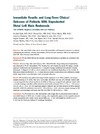Please use this identifier to cite or link to this item:
https://accedacris.ulpgc.es/jspui/handle/10553/75042
| Title: | Immediate Results and Long-Term Clinical Outcome of Patients With Unprotected Distal Left Main Restenosis The CORPAL Registry (Cordoba and Las Palmas) | Authors: | Ojeda, Soledad Pan, Manuel Martin, Pedro Mazuelos, Francisco Suarez de Lezo, Javier Romero, Miguel Segura, Jose Pavlovic, Djordje Medina, Alfonso Suarez de Lezo, Jose |
UNESCO Clasification: | 320501 Cardiología 320704 Patología cardiovascular 321307 Cirugía del corazón |
Keywords: | Coronary-Artery-Disease Drug-Eluting Stent Bypass-Surgery Bifurcation Lesions Intervention, et al |
Issue Date: | 2014 | Journal: | JACC: Cardiovascular Interventions | Abstract: | Objectives The goal of this study was to assess the immediate and long-term outcomes in patients undergoing percutaneous coronary intervention (PCI) for in-stent restenosis (ISR) in an unprotected distal left main coronary artery (UDLM).Background PCI for UDLM-ISR can be complex. Limited information is available on procedural and clinical outcomes. Methods Between May 2002 and February 2011, UDLM-ISR after drug-eluting stent implantation was observed in 79 of 1,102 patients (7%). Seventy-five were treated by repeat PCI using a simple approach (balloon/in-stent implantation) or a complex strategy (additional stent/double-stenting technique). A diagnosis of mild or severe restenosis was considered depending on the number of bifurcation segments affected (1 vs. >1). Major adverse cardiac events (MACE) were defined as cardiac death, target lesion revascularization, and myocardial infarction.Results ISR treatment was performed using a simple approach in 44 (58%) patients, and using a complex strategy in 31 (42%). After 46 +/- 26 months, the MACE rate was 22%. Patients treated with a simple approach had a lower incidence of MACE at follow-up compared with patients treated with a complex strategy, regardless of the restenosis extent (mild restenosis: 93% vs. 67%, p < 0.05; severe: 70% vs. 23%, p < 0.05). On Cox regression analysis, diabetes was the only predictor of MACE (hazard ratio [HR]: 4.94; 95% confidence interval [CI]: 1.03 to 23.70; p < 0.05), whereas a simple strategy for ISR treatment was associated with lower risk (HR: 0.25; 95% CI: 0.08 to 0.79; p = 0.02).Conclusions PCI for UDLM-ISR is safe and feasible, with a high rate of procedural success and an acceptable long-term MACE rate. A simple strategy, when applicable, appears to be a good treatment option, associated with a lower event rate at follow-up. (C) 2014 by the American College of Cardiology Foundation | URI: | https://accedacris.ulpgc.es/handle/10553/75042 | ISSN: | 1936-8798 | DOI: | 10.1016/j.jcin.2013.06.017 | Source: | Jacc-Cardiovascular Interventions [ISSN 1936-8798], v. 7 (2), p. 212-221, (Febrero 2014) |
| Appears in Collections: | Artículos |
SCOPUSTM
Citations
16
checked on Jun 8, 2025
WEB OF SCIENCETM
Citations
14
checked on Jun 8, 2025
Page view(s)
91
checked on May 17, 2025
Download(s)
218
checked on May 17, 2025
Google ScholarTM
Check
Altmetric
Share
Export metadata
Items in accedaCRIS are protected by copyright, with all rights reserved, unless otherwise indicated.
